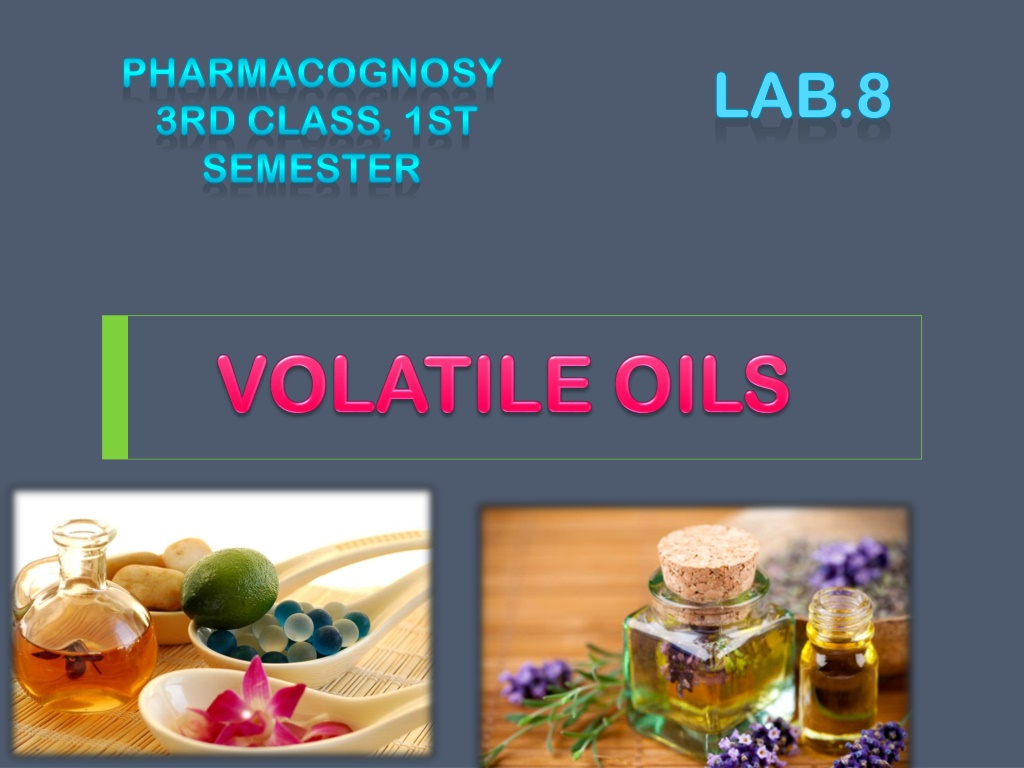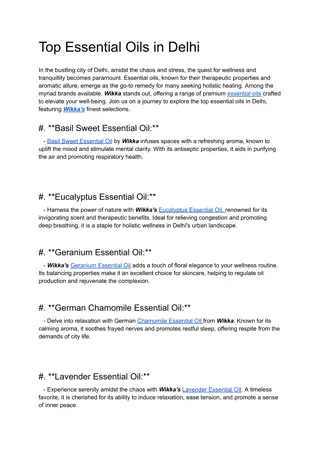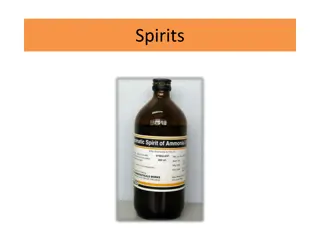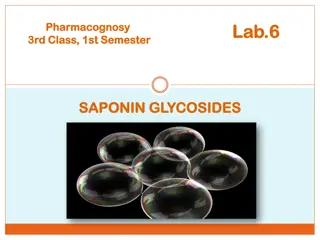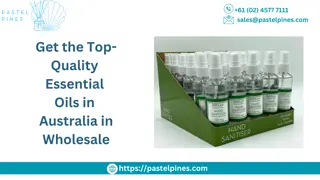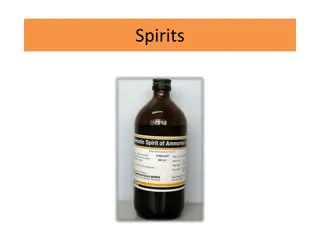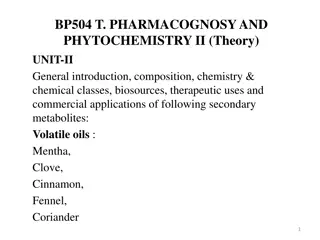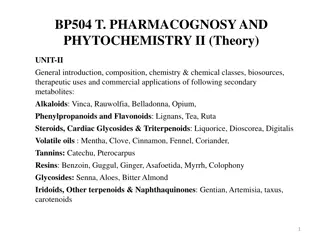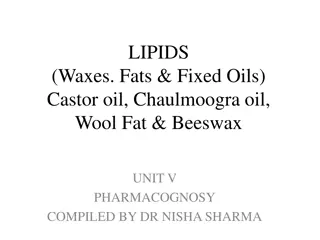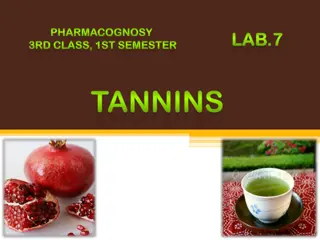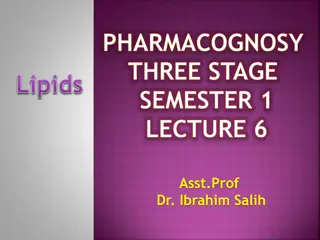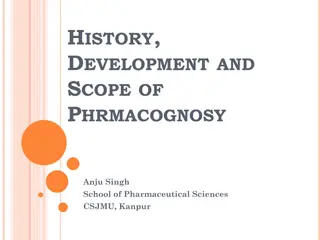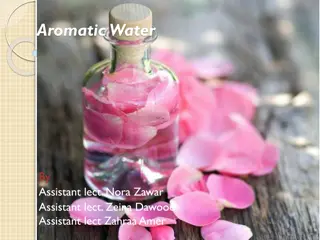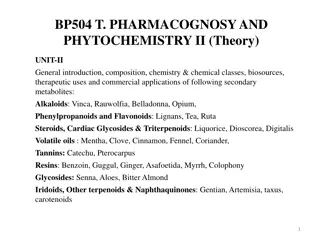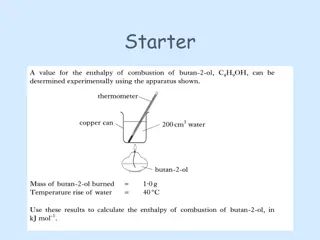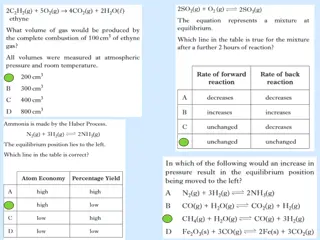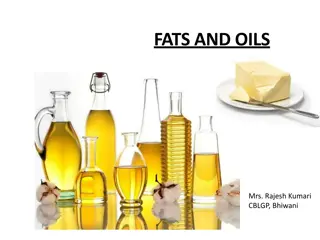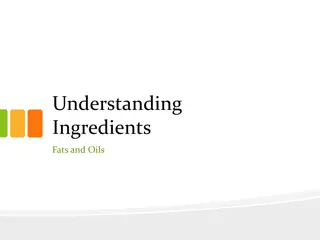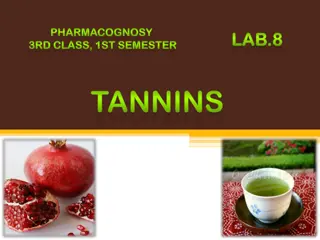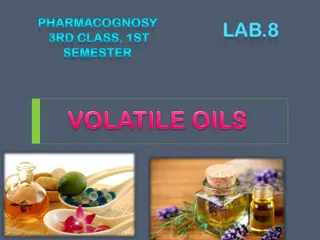Understanding Volatile Oils in Pharmacognosy: Properties, Uses, and Applications
Volatile oils, also known as essential oils, are hydrophobic liquids extracted from plants containing volatile chemical compounds. These oils have diverse physical and chemical properties, making them valuable in various fields like aromatherapy, perfumery, and therapeutics. Learn about the differences between volatile and fixed oils, the origin of official volatile oils, and the different ways volatile oils are used therapeutically and industrially.
Download Presentation

Please find below an Image/Link to download the presentation.
The content on the website is provided AS IS for your information and personal use only. It may not be sold, licensed, or shared on other websites without obtaining consent from the author. Download presentation by click this link. If you encounter any issues during the download, it is possible that the publisher has removed the file from their server.
E N D
Presentation Transcript
PHARMACOGNOSY PHARMACOGNOSY 3 3RD CLASS, RD CLASS, 1 1ST SEMESTER SEMESTER LAB. LAB.8 8 ST
Introduction Volatile oils is a concentrated hydrophobic liquid containing volatile chemical compounds from plants. Because they evaporate when exposed to the air room temperatures, they are called volatile oils, they are also called essential oils or ethereal oils. Volatile oils are colorless as a rule, particularly when they are fresh, but on long standing they are may oxidize and resinify, thus darkening in color to prevent this darkening, they should be stored in a cool, dry place in tightly stoppered, preferably full, amber glass containers.
Cont All official volatile oils are of vegetable origin normally pre-exist in the plant stored in a special secretary tissue ,oil glands, oil cells, glandular hairs. EXCEPTION: Oil of bitter almond formed by hydrolysis of the glycosides.
Physical and chemical properties - Evaporate when exposed to the air at ordinary temperatures, therefore they are called ethereal oil or essential oils (odour of the plants) - Immiscible with water - Soluble in ether and most organic solvent. Chemically they are two class depend on biosynthetic sub units -terpenoids biosynthesized from acetate mevalonate path way - aromatic formed via shikimate pathway
Differences between volatile and fixed oil Volatile oil Fixed oil Terpene or phenylpropane Glycerol ester Can be distilled Can not be distilled, Do not leave a permanent spot on filter paper Leave a permanent spot on filter paper Canot be saponify Saponify with alkalies Oxidize and resinify Rancid when expose to air and sunlight Clove ,menthol and peppermint oil Olive ,musterd andcoconut oli
Uses Of Volatile Oils Therapeutically administered by:- Inhalation (Eucalyptus oil). Orally (Peppermint oil). Gargle and mouthwash (Thymol oil). Transdermal (Lavender, Rosemary). Flavouring Flavouring (Oil of Lemon) Perfumery Perfumery (Oil of Rose) Starting materials Starting materials to synthesize other compounds . Anti Anti- -septic septic due to high phenols (Oil of Thyme). Also as a preservative. Anti Anti- -spasmodic spasmodic (Ginger, Rosemary, Peppermint). Aromatherapy Aromatherapy is the treatment or prevention of disease by use of essential oils and other uses include pain and anxiety reduction, enhancement of energy and short-term memory, relaxation, hair loss prevention. a) b) c) d)
Chemical Composition Terpene derivatives (terpenes are natural products whose structures may be divided into isoprene units formed via the acetate mevalonic acid pathway) for ex: Limonene and Menthol. 1) Aromatic compounds (formed via the shikimic acid-phenylpropanoid route) for ex: Vanillin. 2) Many volatile oils are largely monoterpenoids The monoterpenes (10 carbon atom) are produced by the reaction between two isoprene units by enzymatic reactions.
Cont Generally volatile oils containing drugs are divided into the following classes:- a) Hydrocarbons b) Alcohols c) Aldehydes d) Ketones e) Phenols Phenolic ethers g) Oxides h) Esters f)
Methods of obtaining volatile oils Methods of obtaining volatile oils 1. Steam Distillation: This method is applied to fresh plants for ex: peppermint. 2. Expression: is most commonly used for extracting essential oils from citrus fruit (orange, lemon, grapefruit, etc.). 3. Enfleurage method: is a very old technique of extracting the aromatic oils from flowers that was popularized in France during the 19th century. . 4. Enzymatic hydrolysis: Glycosidic volatile oils like bitter almond, mustard oil is obtained by enzymatic hydrolysis of glycosides. 5. Solvent extraction: This is very costly method and is mostly used in perfume industry. The parts containing volatile oil are extracted directly by one of the organic solvents and they are then separated.
Determination of the volatile content by steam distillation method Apparatus: - Clevenger apparatus is used to determine the volatile oil content in a given sample. The oil layer settles on top of the aqueous layer.
